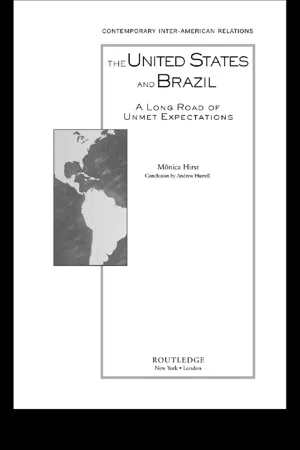CHAPTER 1
HISTORICAL BACKGROUND
RELATIONS BETWEEN THE UNITED STATES AND BRAZIL HAVE ebbed and flowed over time; for almost two hundred years they have oscillated between close alignment and cold indifference, according to the level of convergence and/or discrepancy between the two countries. Yet their shared American heritage, together with their power attributes—territory, population, and size of economy—have always made it difficult for either side to turn a blind eye to the other.1
Until the late nineteenth century, relations between the two countries were sporadic, as was then the norm in inter-American relations. Their dominant ties were with the European world—particularly with Great Britain—and wars and border settlements occupied almost all of the foreign agendas of the two countries.
U.S.-Brazil relations gained weight as bilateral economic and political interests gradually flourished in the last decade of the nineteenth century. While Brazilian republican movements looked to the U.S. political experience as a source of inspiration, the United States opened its market to coffee, Brazil’s main export. The relationship picked up once Brazil abolished slavery and became a republic. Since then, U.S.-Brazil relations have developed different significant trends, which will now be discussed individually.
ALLIANCE
During Brazil’s First Republic (1889–1930), U.S.-Brazil relations followed the pattern of a loose alliance, one that Bradford Burns has characterized as an “unwritten alliance.”2 While no mutual military assistance was involved, reciprocal diplomatic support and close economic ties knitted a strong friendship between the two nations. For Brazil, this relationship was premised on the diagnosis of a scenario in which Eurocentric interests would not last long as the core of world affairs, and the United States would become a vigorous international actor. Barão de Rio Branco, foreign minister (1902–12) and founding father of twentieth-century Brazilian diplomacy, was the main architect of this conception.
Nevertheless, it is important to keep in mind that the idea of giving preference to the strengthening of relations with the United States was conceived in a multipolar world system, and was based upon the belief that it would be more likely that this structure would experience relevant adjustments than a complete collapse. In other words, Brazil’s relations with the United States did not anticipate the constraints that latter would be imposed by U.S. hegemony. Hence, in those days, Brazil and the United States basically met each other’s expectations.
The First Republic (1889–1930) was a decisive era for Brazil in the diplomatic arena, and essential premises instituted during this period still provide a necessary backdrop for understanding contemporary Brazilian foreign policy. It was at this time that Brazil’s Foreign Ministry affirmed its position as the dominant actor in formulating and conducting Brazil’s foreign affairs. Following the settlement of most long-standing territorial disputes with its South American neighbors, Brazil began to exhibit greater interest in engaging in multilateral diplomacy and developing closer ties with the United States. At this time, the United States was perceived as the ascendant power in the international system. Hence, at the turn of the nineteenth century, as Brazil gradually distanced itself from the British sphere of influence, U.S.-Brazil relations began to flourish. Early U.S. support for Brazil’s provisional government, established in 1889, helped solidify the relationship. The Treaty of Commercial Reciprocity (1891) augmented existing commercial ties between the two nations, as did the subsequent U.S. naval presence off the Brazilian coast.3
Throughout the First Republic, Brazil hoped to crystallize its alliance with the United States, which praised the settlement of the border disputes between Brazil and Argentina, and supported Brazil in its territorial negotiations with British and French Guyana. Brazil reciprocated when it supported the U.S. government politically and logistically during the 1898 war with Spain. The two countries continued to cultivate diplomatic relations, as evidenced by the inauguration of their respective embassies in each other’s capitals. Most telling of all is the fact that the U.S. embassy in Rio de Janeiro was the first that the United States opened anywhere on the entire South American continent, while the Brazilian embassy in Washington, D.C., was Brazil’s first embassy abroad.
The years of Rio Branco at the Foreign Ministry were crucial for the creation of the special relationship with the United States. Both Rio Branco, as foreign minister, and Joaquim Nabuco, as ambassador, worked hard to assure that the United States showed goodwill toward the governments of the First Republic.
Rio Branco was especially concerned with consolidating harmonious relations with the most prominent partner in the Americas, but he believed close relations with the United States should not overshadow other alliances in the region, particularly the alliance with Argentina. Hence, Rio Bronco’s idea of creating an entente among Brazil, Argentina, and Chile did not exclude the maintenance of close relations with the United States. Later, U.S. support for Brazilian naval rearmament (1913) was reinforced by negotiations in 1922 for a cooperative military program.
Positive bilateral relations during the First Republic, however, did not preclude some divergence in diplomatic stance between the two. For instance, the United States and Brazil stood for different viewpoints in the Second Hague Peace Conference (1907), on the division of Colombia and the consequent creation of Panama, and on certain trade negotiations. Furthermore, “dollar diplomacy,” which led to continuous U.S. interventions in Latin America, fed a growing controversy within Brazilian diplomatic and political circles on the pros and cons of close relations with the United States.
In the early twentieth century, trade relations with the United States were crucial for Brazil, but they were highly asymmetrical from the start. Between 1910 and 1914, for instance, 38 percent of Brazilian exports were geared toward the United States, whereas a mere 1.5 percent of U.S. exports were destined for Brazil. After World War I, U.S. exports to Brazil grew substantially,4 and the United States became a leading investor in Brazil, especially after the expansion of transportation and mining. At the time, a decrease in the number of British firms in Brazil correlated with an increased U.S. presence.
This picture began to change in the mid-1930s, when U.S. expectations regarding Latin American economic and political loyalty increased. Brazil’s 1930 revolution paved the way for major political and economic transformations that reflected on its relations with the United States. The 1930s can be considered a transition period in U.S.-Brazil relations. The new civil and military elite that came to power deepened the link between foreign affairs and domestic economic policies, and growing international tensions, coupled with major changes in the domestic affairs of both Brazil and the United States, engendered a unique situation for the relationship. While German influence expanded in Brazil, the United States pushed for the intensification of economic, political, and cultural ties with all Latin American countries, particularly Brazil. This effort was carried forward in the framework of the “good neighbor policy.”
In this context, Brazilian foreign affairs became increasingly influenced by the commercial options posed by the U.S.-German rivalry. Whereas the United States insisted on free trade, Germany offered Brazil the advantages of compensated trade. The administration of Getúlio Vargas (1930–45) pragmatically analyzed the benefits of an expanded relationship with Germany at the cost of Brazil’s traditional partnership with the United States, while it tried to extract maximum advantages from relations with both countries.5
With the strengthening of industrial interests, an internal debate over foreign economic policy surfaced. In 1935, a controversy arose regarding the trade agreement negotiated with the United States in that same year. Following the liberal principles of U.S. economic policy, this treaty established the reciprocal concession of Most Favored Nation status. It also considered preferential treatment for some Brazilian products (coffee, cocoa, and rubber, among others) in exchange for tariff reductions ranging from 20 percent to 60 percent on industrial products such as machines and stainless steel. The political difficulties facing the treaty’s approval in Brazil generated a great deal of apprehension in the United States, which was worried about Brazilian protectionism and the country’s increased trade with Germany. The Brazilian Congress finally ratified the agreement in 1936.
Oswaldo Aranha, first as Brazilian ambassador to Washington (1934–37), and later as foreign minister (1938–44), advocated the political and economic advantages of deepening relations with the United States. In order to sustain this position, negotiations were undertaken with the U.S. government for the financing of a Brazilian national steel plant and for the modernization of the Brazilian armed forces. Thus, the economic, military, and cultural connections between the two nations were strongly reinforced.
But the onset of World War II in 1939 highlighted the stakes surrounding alignment with the United States. Hoping to conserve an equidistant position vis-à-vis the Allies and the Axis powers, Brazil initially declared its neutrality. Notwithstanding, this commitment to neutrality proved illusory. U.S. involvement in World War II immediately increased pressure from Washington for Latin American alignment. In the case of Brazil, full support was deemed necessary not only for political reasons but because of the strategic importance of Brazil’s northeastern coast during the first phase of the war. In August 1942, after a complex process of negotiations, Brazil’s alignment with the United States was fully achieved.
While the decline of Brazilian trade with Germany as a consequence of the U.S. naval blockade had circumscribed Vargas’s bargaining power, henceforth he would capitalize on his newly acquired leverage by committing Washington to Brazil’s economic development. The pro-U.S. sectors were willing to completely give up trade with the Third Reich on the condition that the United States establish a “special relationship” with Brazil, involving deep economic and military cooperation. The new terms of the U.S.-Brazil relationship would accompany Brazil’s decision to break off relations with the Axis powers. For Vargas, it was essential that Brazil be compensated for its concessions to the United States via the reequipping of its armed forces.6 Pro-U.S. solidarity oriented Brazil’s actions during the Third Meeting of Consultation of American Foreign Ministers, which took place in January 1942 and also resulted in the decision by the Latin American nations—with the exception of Argentina and Chile—to break off relations with the Axis powers.
The 1942 Washington Agreements, in which the United States offered Brazil a 100-million-dollar loan for the aforementioned steel plant, met previous expectations. Moreover, the two countries signed a secret...

